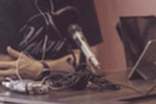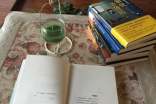【篇一】“一般现在时”和“现在进行时”两种时态的结构。
一般现在时和现在进行时区别及习题
一般现在时和现在进行时是初一阶段所学的两种重要时态,它们的不同之处有以下几点:
1)基本用不同;2)谓语动词的形式不同;3)时间状语不同;4)有不同的特殊用法。
一、基本用法不同
【1】一般现在时用来表示习惯性的动作或状态。如:She goes to school by bike every day.她每天骑自行车去上学。
【2】现在进行时用来表示现在(说话的瞬间)正在发生或进行的动作或者用来表示现阶段正在进行或存在的状态。如:Look ! She is reading under the tree.瞧!她正在树下看书。
二、谓语动词的形式不同
【1】一般现在时的谓语动词:1) be动词用am/is/are这三种形式;2)实义动词用动词原形或第三人称单数形式(根据主语数的变化而变化)。
【2】现在进行时谓语动词的形式为: am / is / are+动词-ing 形式。如: We go to school at seven in the morning.我们早晨七点钟上学。 I am reading English now. 我现在正在读英语。
三、时间状语不同
【1】一般现在时常与often, sometimes, always, usually等频率副词及once a week/day等频率短语连用,还与 every morning /day / week…, on Wednesday, in the morning / afternoon / evening等时间状语连用。
【2】现在进行时常与now, these days, these weeks等时间状语连用。句首有 Look ! / Listen !等提示语时,后面的句子中动词一般用现在进行时。
四、特殊用法
1. 一般现在时的特殊用法: 表示客观真理、自然现象往往要用一般现在时表示。如:The moon goes round the earth.月亮绕着地球转。
2. 现在进行时的特殊用法: 现在进行时与always 连用时,往往含有赞扬、厌恶、责备等感情色彩。如: He is always working hard.他总是非常努力地工作。(表示赞扬)
come, go, begin, start, leave 等动词常用现在进行时表示将要发生的动作。如:I'm coming. 我就来。
一、选择题练习
1. Who _____ over there now? A. singing B. are sing C. is singing D. sing
2. It’s eight o’clock. The students _____ an English class.
A. have B. having C. is having D. are having
3. Listen! The baby _____ in the next room.
A. crying B. cried C. is crying D. cries
4. Look! The twins _____ new sweaters.
A. are wearing B. wearing C. are wear D. is wearing
5. Don’t talk here. Grandparents _____.
A. is sleeping B. are sleeping C. sleeping D. sleep
6. Tom is a worker. He _____ in a factory. His sisters _____ in a hospital.
A. work/ work B. works/ work C. work/ works
7. Who _____ English best in your class? A. speak B. speaks C. speaking
8. Mrs Read _____ the windows every day. A. is cleaning B. clean C. cleans
9. We _____ music and often _____ to music.
A. like/ listen B. likes/ listens C. like/ are listening
10. She _____ up at six in the morning. A. get B. gets C. getting
11. On Sunday he sometimes _____ his clothes and sometimes _____ some shopping.
A. wash/ do B. is washing/ is doing C. washes/ does
12. The twins usually _____ milk and bread for breakfast, but Jim _____ some coffee for it.
A. have/ have B. have/ has C. has/ have
二、填空:
1. My father always __________(come) back from work very late.
2. The teacher is busy. He __________ (sleep) six hours a day.
3. Listen! Joan __________(sing) in the classroom. She often __________ (sing) there.
4. __________ your brother __________(know) Japanese?
5. Where __________ you __________ (have) lunch every day?
6. The girl __________(like) wearing a skirt. Look! She __________(wear) a red skirt today.
三、写出下列动词的现在分词形式
1. work___________ sing__________ play__________ study__________
2. dance__________ have__________ write__________ take__________
3. run__________ sit__________ shop__________ swim__________
4. lie__________
四、写出下列动词的第三人称单数形式
1. work__________ read__________ clean__________ write__________
2. teach__________ wash__________ guess__________ watch__________
3. go__________ do___________ photo__________
4. study__________ fly__________ cry__________ play__________
5. have__________
五、根据中文意思完成句子
1、学生们在干什么?有一些在打电话,另一些躺在沙滩上。_____ _____ the students _____? Some _____ _____ on the phone, _____ _____ _____ on the beach.
2、“格林先生在看电视吗?” “不, 他在打扫房间。”
“_____ Mr Green _____ TV?” “_____, He _____ _____ the house.”
3、魏芳不是在读书,她在写信。
Wei Fang _____ _____ a book. She _____ _____ a letter.
4、我正在通过收音机学 (learn) 英语。 I _____ _____ English on the radio.
5、这个老人每天早上六点钟起床。
The old man _____ _____ at six o’clock in the morning every day.
6、你从哪里来? Where _____ you from? 或Where _____ you _____ from?
我从美国来。 I _____ from America. 或I _____ from America.
【篇二】“一般现在时”和“现在进行时”两种时态的结构。
一般现在时与现在进行时的用法及区别
一般现在时的用法:
1.表示习惯的、永久性的或经常、反复发生的动作,常与often, always, usually, every day, sometimes, every week, once a day等时间状语连用。例如: I am a teacher.
We are Chinese.
She goes to work every day.
He always helps others.
2.表示客观事实或普遍真理。例如:
There are seven days in a week.
The earth goes round the sun.
The sun rises in the east and sets in the west.
The water boils at 100℃.
Actions speaks louder than words. 行动胜于言辞。(谚语)
3.表示主语的特征、性格、能力等。
Tom studies very hard.
She is always ready to help others.
I major in English.
4.用在某些表达法中,表示现在正在发生的动作或存在的状态。例如: Here comes the bus!
There goes the bell!
How it rains!
5. 表示现在时刻存在着的状态,这种状态带有一定的持续性。例如: They are busy.
The apple tastes good.
What’s the matter with you?
6.在连词when, before, if, as soon as, until 等引导的表示将来的行为的状语从句中,常用一般现在时表示将来的动作。例如;
If it is fine tomorrow, we’ll have a football match.
I’ll ring you up before I leave the office.
When I finish my homework, I’ll tell you a story.
7.表示安排或计划好的未来的动作,只限于go, come, leave, move, start, stay, return, arrive, begin 等表示位置移动变化的动词。例如:
My train leaves at 6:30 this morning.-
How long do you stay here?
We start at 8 tomorrow morning for Beijing.
8.一般现在时还可用在新闻标题、戏剧或电影的评论及情节介绍、体育比赛的解说以及图片的说明等场合。
Tom carries the ball to the left. 汤姆把球带到左方。
The picture shows us how they built the motorway last year.
这张照片给我们展示了他们去年如何建设高速公路。“一般现在时”和“现在进行时”两种时态的结构。
现在进行时的用法:
1. 表示说话时正在进行而尚未完成的动作或状态
Performances are going on.
The children are singing a fine song.
2. 表示现阶段一直在进行的动作,但说话时不一定正在进行
My uncle is attending a conference in Beijing.
He is translating a book.
3. 有时可表示即将发生的动作,只限于go, come, leave, move, start, stay, begin 等动词
My father is leaving for Kunming tomorrow.
They are coming back here in a few minutes.
4. 与always, continually, constantly, perpetually, forever等频度状语连用,表示带有感情色彩的现阶段经常发生的动作
You are always forgetting the important things.
You are constantly finding fault with me.
5. 有些表示感觉、情感、认知的词,不能用进行式,通常用一般现在时表示说话时正在发生的动作,如:know, believe, understand, love, like, hate, feel, hear, see, desire, wish, hope, want, refuse, remember, forget, belong, prefer, miss(想念),have(有), think(认为)等动词
I don’t understand this sentence.
It surprises me to see the repair work going so fast.
I have a pen.
We are having a talk now. (have表示“举行”)
I think they are right.
What are you thinking about? (think表示“想,思考”)
现在进行时与一般现在时用法比较:
1. 现在阶段正在进行的动作和陈述情况说明事理
He is reading the newspaper.
He reads the newspaper every day.
2. 暂时性的动作和经常性的动作
For this week we are starting work at 7:30 am.
We start work at 7:30 am.
3. 短暂性的动作和永久性的动作
She is living in Shanghai.
She lives in Shanghai.
4. 带有感情色彩的和不带感情色彩的
She is always helping me in the kitchen. She always helps me in the kitchen.
【篇三】“一般现在时”和“现在进行时”两种时态的结构。
一般现在时和现在进行时的区别总结
一般现在时和现在进行时的区别
一、 概念不同: 一般现在时表示主语经常性和习惯性的动作或存在的状态,也表示说话者的能力及自然现象。而现在进行时表示说话时(瞬间)正在进行的动作,也表示目前或现阶段一直进行的动作。
如: She often does her homework in the evening. 她经常在晚上做作业。 She is doing her homework now. 现在她正在做作业。
二、在构成方式上的不同: 一般现在时中谓语动词的构成有以下三种情况:
①be动词的一般现在时形式:am,is,are.
②动词have的一般现在时形式:have,has.
③其他行为动词的一般现在时形式有动词原形或第三人称单数形式。 而现在进行时中谓语动词的构成是:am/is/are+动词的-ing形式(现在分词)。
三、时间状语不同: 一般现在时的时间状语主要有:always,usually,often,sometimes,never,every day,on Sundays,in the morning/afternoon/evening等; 现在进行时的时间状语主要有:now,these days,this week,at the moment等,有时句首有“Look!”、“Listen!”或“It’s+时刻”等词、句存在。
如: We play football in the afternoon.我们在下午踢足球。(一般现在时) My mother is reading a newspaper now. 我妈妈正在看报纸。(现在进行时)
四、感情色彩不同: 一般现在时往往不带任何感情色彩,语气比较肯定。现在进行时常带有一定的感情色彩,并多与always, often等副词连用。
如: Mr. Li works hard in the factory. 李先生在工厂工作努力。(说明事实,语气比较肯定) Mr. Li is always working hard in the factory.李先生在工厂工作一直很努力。(表示赞扬)
五、用语范围不同: 某种表示情感、意识(如want,like,know等);表示“有”的have等动词,一般不用于现在进行时,但可用于一般现在时。
如: 我现在就想回家。 误:I am wanting to go home now. 正:I want to go home now. 他有一台电脑。 误:He is having a computer. 正:He has a computer.
六、时间范围不同: 这两种时态所表示的时间范围都可能有“过去——现在——将来”的意味,但相对而言,一般现在时持续的时间较长,甚至无限。而现在进行时持续的时间较短,可能片刻完成。 如: She comes from Shanghai. 她是上海人。 She is coming from Shanghai.她正从(或即将从)上海来。
【篇四】“一般现在时”和“现在进行时”两种时态的结构。
一般现在时和现在进行时总结
三联英语 15.12.6课堂总结
一.一般现在时 主语+动词原形+其它 如果主语是第三人称 动词变单三形式 1.标志词
every day 每天 every week 每月 every month 每月 every year 每年 on Sundays 在周日 On Monday 在周一 in the evening 在晚上, on Sunday morning在星期天的早上 in the evening every day在每天晚上 2.频率副词
always(总是), usually(通常), often(经常), sometimes(有时候), seldom(极少),rarely(很少),hardly ever(几乎不),never(从不) 这七个词语,表示动作的次数依次由多到少,这些词语叫频率副词。 例如:
1.我每天做作业 (要写做我的作业 不能直接写做作业)
I do my homework. I —you my—- your 你做的你的家庭作业吗?变疑问: Do you do your homework? 我不做我的家庭作业.变否定:I do not do my homework.
或 I don't do my homework.
2.他每天在教室里做作业 (要先写地点 再写时间) He does his homework in the classroom every day..
变疑问:Does He do his homework in the classroom every day? 变否定:He does't do his homework in the classroom every day. 他正在教室里做作业 He is doing his homework in the classroom 。
3.我的妈妈和我周末去超市. 不是单三形式
My mom and I go to ghe shops every weekend.
变疑问:Do your mom and you go to ghe shops every weekend ? 变否定: My mom and I don't go to ghe shops every weekend. 4.她每天看电视
She watches TV every day
变疑问:她每天看电视吗?Does she watch TV every day? 变否定:She doesn't watch TV every day。 5.露西和李丽每月去公园。不是单三形式 Lucy and Li Li go to the park every month.
变疑问:Do Lucy and Li Li go to the park every month? Lucy and Li Li don't go to the park every month.
一般现在时 主语+动词原形+其它 如果主语是第三人称 动词变单三形式
基本用法
1. 表示经常性或习惯性的动作或存在的状态 2. 表示客观事实或普遍真理
3. 在时间、条件等状语从句中,用一般现在时表示将来
4. 在某些以here,there开头的句子中,用一般现在时表示正在发生的动作 当主语是第三人称单数时: 动词变相应的第三人称单数形式 肯定句主语+动词s+其它
否定句主语+doesn't+动词原形+其它 一般疑问句Does+主语+动词原形+其它 肯定回答 Yes,主语+does 一般现在时的分析
否定回答 No,主语+doesn't 特殊疑问句特殊疑问词+一般疑问句 当主语不是第三人称单数时: 肯定句 主语+动词原形+其它 否定句 主语+don't+动词原形+其它 一般疑问句 Do+主语+动词原形+其它 要注意,句式结构错则全都错。 谓语动词的形式:do/does
变化规律
【篇五】“一般现在时”和“现在进行时”两种时态的结构。
一般现在时和现在进行时 最全知识点
一般现在时
一般现在时第一节——基本知识
一般现在时表示经常重复性的动作或是存在的状态。
例如:他喜欢睡觉。He likes sleeping. I’m a teacher.(状态) 我经常在周末去看望祖父母。I often go to see my grandparents at the weekend.(重复性的动作) 标志词:
always usually often sometimes never everyday everyweek at+时间 on+Sundays (解释at+时间——at five o’clock at a quarter past seven等 表示具体的几点几分 解释on+Sundays——on加表示星期的单词 包括Monday Tuesday等)
标志词的作用:
1.做题时,帮助孩子迅速确定这句话的时态,填入相应的动词形式
2.初期学习,标志词是可以准确对应时态的,但是随着知识的加深,一个标志词变不只代表这一种时态, 这时候,就需要把标志词这个拐杖扔掉了。所以标志词的学习,就是让孩子有时态的意识,并熟知各 大时态动词的形式,乃至以后,这句话中没有标志词了,孩子也会正确表达出符合此句话意境(时态) 的句子。
一般现在时动词形式:
1.be原形 am is are
You are a boy. I am a thin girl. The Whites are at the beach. He is collecting shells.
2.动词原形及单三
Sally usually does(单三) her homework in her bedroom.
We have(原形)dinner together.
什么是单三?
单三就是人称的第三人称单数。如果人称是单三,那么动词也得跟着变单三。
判断方法
除了I和you这两个单词之外的所有单数意义的词 I you
单数 复数
做个小练习——找单三
a girl photos a bowl she I he water it the tree Mary a fat dog they
leaf you leaves we three boys May
Tony man men the desk English class a red hat 动词变单三
记不记得判断出人称是单三了 动词也得跟着变单三啊?
动词变单三的方法和名词变复数是一样的。一.大部分的单词直接加s 二.以ch sh s x结尾的动词加es
三.辅音加y改y为ies 四.以o结尾的加es 举例:
一.直接加s put-puts open–opens dance–dances
二.加es watch–watches wash–washes plus–pluses
三.辅音加y 改y为ies fly–flies 注意:play–plays(元音加y)
四.以o结尾加es do–does go–goes
做练习:将下列单词变单三
work________________clean_______________write_______________drink_______________ stay_______________brush_______________carry_______________pass_______________
come_______________plant_______________fly_______________play_______________
look_______________have_______________do_______________go_______________
现在来试试做一般现在时的练习题:
Judy说在前头:1.划标志词 2.记住判断人称是不是单三 3.人称是单三的话,动词得变单三啊!
We often __________________(play) in the playgound.
He __________________(get) up at six o’clock.
Danny __________________(study) English,Chinese,Maths,Science and Art at school.
Mike sometimes __________________(go) to the park with his sister.
At eight at night, she __________________(watch) TV with his parents.
答案: 找单三:
photos I
they
you leaves we three boys men
做练习:将下列单词变单三
work_______s_________clean________s_______write_______s________drink________s_______
stay______s_________brush_______es________carry y去掉ies________pass________es_______ come______s_________plant______s_________fly y去掉ies_________play_______s________ look________s_______have____has____do________es_______go_______es________
时态练习
We often _____plays_____(play) in the playgound.
He ____gets___(get) up at six o’clock.
Danny ____studies____(study) English,Chinese,Maths,Science and Art at school.
Mike sometimes _____goes____(go) to the park with his sister.
At eight at night, she ____watches_______(watch) TV with his parents.
一般现在时第二节——句型转换
一般疑问句:一提 二变 三改
1.be动词提前
2.变——I变you me变you we变you us变有 my变your our变your
I am变Are you
3.改——句号改问号
例如:We are giving our best wishes to her.
Are you giving your best wishes to her?
练习:
I am doing my homework in the living room.
_________ ___________doing__________ homework in the living room?
We are dancing at the birthday party of Mary’s.
_______ _________dancing at the birthday party of Mary’s?
My father is taking me home.
_______ ________father taking__________home?
Our teacher is talking with us.
_________ __________teacher talking with_____________?
答案:
I am doing my homework in the living room.
Are you doing your homework in the living room?
We are dancing at the birthday party of Mary’s.
Are you dancing at the birthday party of Mary’s?
My father is taking me home.
Is your father taking you home?
Our teacher is talking with us. Is your teacher talking with you?
一般疑问句:一写 二变 三改
1.动词原形写do 动词单三写does 写完does 动词单三还原
2.变——I变you me变you we变you us变有 my变your our变your
I am变Are you
3.改——句号改问号
例如:
1.My mother washes the dishes for our family everyday.
Does your mother wash the dishes for your family everyday?
2.My family drink milk every morning.
Do your family drink milk everyday?
练一练
1.My mother washes the dishes for our family everyday.
_________ _________mother________the dishes for________family everyday?
2.My family drink milk every morning.
_______ _______ family_______milk every morning?
3.They tell me to go to the park at four o’clock in the afternoon.
_________they__________ ___________to go to the park at four o’clock in the afternoon?
4.He tells me to go to the park at four o’clock in the afternoon.
_________he__________ ___________to go to the park at four o’clock in the afternoon?
答案:
1.My mother washes the dishes for our family everyday.
Does your mother wash the dishes for your family everyday?
2.My family drink milk every morning.
Do your family drink milk everyday?
3.They tell me to go to the park at four o’clock in the afternoon.
Do they tell you to go to the park at four o’clock in the afternoon?
4.He tells me to go to the park at four o’clock in the afternoon.
Does he tell you to go to the park at four o’clock in the afternoon?
否定句
Be动词后直接加(not)“一般现在时”和“现在进行时”两种时态的结构。
I am not a student.
He isn’t collecting shells at the beach.
They aren’t watching TV in the living room.
(这个很简单 孩子都会,就不多讲了)
动词原形否定用don’t
My family drink milk every morning.
否定:My family don’t drink milk every morning.
动词单三否定句用doesn’t 写完doesn’t动词单三还原
My mother washes the dishes for our family everyday.
My mother doesn’t wash the dishes for our family everyday.
练习:“一般现在时”和“现在进行时”两种时态的结构。
1.I have many books.
I_____________ ______________ many books.
2.Gao Shan’s sister likes playing table tennis.
Gao Shan’s sister_____________ ______________playing table tennis
3.My dog runs fast.
My dog_____________ ______________fast.
4.Mingming usually waters the flowers every day
Mingming usually _____________ ______________ the flowers every day
5.Tom does his homework at home.
Tom _____________ ______________his homework at home.
答案
1.don’t have 2.doesn’t like 3.doesn’t run 4.doesn’t water 5.doesn’t do
现在进行时
意义:表示正在进行的动作。
例如:I am watching TV in the living room.我正在客厅里看电视。
We students are having an English class.学生正在上英语课。
标志词
look,listen,now,It’s+时间,Don’t祈使句。
Eg:Look!The children are flying kites in the park happily!
Listen!There is a bird singing in the tree.
Now we are working hard.
It’s a quarter past seven.The Greens are having dinner.
Don’t make s noise.The little girl is sleeping sweetly.
(小学阶段还有个Where’s your mother?Where开头的特俗疑问句。
例:Where’s your mother?She is cooking in the kitchen. 中学阶段就不看标志词了,根据语感来判断时 态,所以小学阶段,让孩子正确变化词形,掌握be+ing的结构就可以。)
让孩子做个输出小检测
标志词有:________________ _____________ _______________ ________________ __________________
标志词的作用:
1.做题时,帮助孩子迅速确定这句话的时态,填入相应的动词形式
2.初期学习,标志词是可以准确对应时态的,但是随着知识的加深,一个标志词变不只代表这一种时态, 这时候,就需要把标志词这个拐杖扔掉了。所以标志词的学习,就是让孩子有时态的意识,并熟知各 大时态动词的形式,乃至以后,这句话中没有标志词了,孩子也会正确表达出符合此句话意境(时态) 的句子。
现在进行时的动词形式:
有be 必有ing(be动词加动词的现在分词 就是动词的ing形式)
Eg:I am collecting shells on the beach.
He is enjoying the sunshine.
They are swimming in the sea.
动词怎么变现在分词
一直 二去 三双写 四ie变ying
一直:直接加ing go-going walk-walking talk-talking
二去:去结尾不发音的e加ing make-making write-writing date-dating
三双写:重读辅元辅 put-putting stop-stopping shut-shutting
四ie变ying tie(之前我们学的这个单词是领带的意思 它还有系,绑的意思 如 What is he doing?He is tying his tie.他正在系领带。)
【注:四个单词辅元辅 但是不双写play-playing listen-listening buy-buying open-opening 】
【注:根据规律可以写出没学过的或是不熟悉的单词的现在分词 但是孩子能正确的写出一个动词的现在分词 不是靠规律 是靠熟练程度 比如孩子写swimming 不是想着规律写出来的 而是就这么写顺手 所以通过规律是拐杖 写现在分词 如果写错了 不是强调规律而是多练几遍 练熟了 再把拐杖丢了】
做练习:将下列单词便现在分词 do______________skip______________sing______________cut______________dance______________ take______________have______________jump______________swim______________run______________mak______________use______________give______________help______________watch______________ put______________close______________open______________buy______________talk______________ lay______________listen______________tie______________die______________collect______________
现在来试试做现在进行时的练习题:
Judy说在前头:1.划标志词 2.记住现在进行时 be动词必不可少 3.注意现在分词的词形变化
1.Look,the boy________________(run)fast.
2.You______________________(listen)tO me now.
3.—-What are you doing? —-I___________________(do) my homework.
4.—-_________________the students_________________(read) English. —-Yes,they are.
5.—-Who____________(sing)a song? —-Li Ying is.
6.Look! The boy over there_________________(play) a model plane.
7.Don’t talk in the library.All the people__________________(read).
8.It’s nine o’clock.Tom________________still______________(do)his homework.
9.It’s nine ten. The students___________________(have)a music class
将下列句子转换成现在进行时(注:要有be有ing)
1. He talks to a friend._____________________________________________________________________
2. They play computer games._____________________________________________________________
3. They look at the blackboard._____________________________________________________________
4. He swims in the sea.____________________________________________________________________
5. Lucy writes a letter to his grandma.________________________________________________________
答案:1.are running 2. Are listening 3.am doing 4.Are,reading 5.is singing 6.is playing
7.are reading 8.is,doing 9.are having
1.He is talking to a friend.
2.They are playing computer game.
3.They are looking at the blackboard.
【篇六】“一般现在时”和“现在进行时”两种时态的结构。
一般现在时和现在进行时区别及习题
一般现在时
一.一般现在时描述现在或经常性的动作性质或状态的时态
1.He has a strong accent of an America(现在的状态)
2.Light travels much faster than sound.(客观事实)
3.They go to church every Sunday.(习惯性,经常性)
4.The train arrives at 10:30pm. There is plenty of time.(按时间表,计划,规定将要发生)
5.在时间状语从句和条件状语从句中代替一般将来时。If you arrive,please give me a phone call.
5.表示正在存在的状态。 There goes the bell. How hard it rains
一般现在时和现在进行时是初一阶段所学的两种重要时态,它们的不同之处有以下几点:“一般现在时”和“现在进行时”两种时态的结构。
1)基本用不同;2)谓语动词的形式不同;3)时间状语不同;4)有不同的特殊用法。
一、基本用法不同
【1】一般现在时用来表示习惯性的动作或状态。如:She goes to school by bike every day.她每天骑自行车去上学。
【2】现在进行时用来表示现在(说话的瞬间)正在发生或进行的动作或者用来表示现阶段正在进行或存在的状态。如:Look ! She is reading under the tree.瞧!她正在树下看书。
二、谓语动词的形式不同
【1】一般现在时的谓语动词:1) be动词用am/is/are这三种形式;2)实义动词用动词原形或第三人称单数形式(根据主语数的变化而变化)。
【2】现在进行时谓语动词的形式为: am / is / are+动词-ing 形式。如: We go to school at seven in the morning.我们早晨七点钟上学。 I am reading English now. 我现在正在读英语。
三、时间状语不同
【1】一般现在时常与often, sometimes, always, usually等频率副词及once a week/day等频率短语连用,还与 every morning /day / week…, on Wednesday, in the morning / afternoon / evening等时间状语连用。
【2】现在进行时常与now, these days, these weeks等时间状语连用。句首有 Look ! / Listen !等提示语时,后面的句子中动词一般用现在进行时。
四、特殊用法
1. 一般现在时的特殊用法: 表示客观真理、自然现象往往要用一般现在时表示。如:The moon goes round the earth.月亮绕着地球转。
2. 现在进行时的特殊用法: 现在进行时与always 连用时,往往含有赞扬、厌恶、责备等感情色彩。如: He is always working hard.他总是非常努力地工作。(表示赞扬)
come, go, begin, start, leave 等动词常用现在进行时表示将要发生的动作。如:I'm coming. 我就来。
一、选择题练习
1. Who _____ over there now?
A. singing B. are sing C. is singing D. sing
2. It’s eight o’clock. The students _____ an English class.
A. have B. having C. is having D. are having
3. Listen! The baby _____ in the next room.
A. crying B. cried C. is crying D. cries
4. Look! The twins _____ new sweaters.
A. are wearing B. wearing C. are wear D. is wearing
5. Don’t talk here. Grandparents _____.
A. is sleeping B. are sleeping C. sleeping D. sleep
6. Tom is a worker. He _____ in a factory. His sisters _____ in a hospital.
A. work/ work B. works/ work C. work/ works D works/works
7. Who _____ English best in your class?
A. speak B. speaks C. speaking
8. Mrs Read _____ the windows every day.
A. is cleaning B. clean C. cleans
9. We _____ music and often _____ to music.
A. like/ listen B. likes/ listens C. like/ are listening
10. She _____ up at six in the morning. A. get B. gets C. getting
11. On Sunday he sometimes _____ his clothes and sometimes _____ some shopping.
A. wash/ do B. is washing/ is doing C. washes/ does
12. The twins usually _____ milk and bread for breakfast, but Jim _____ some coffee for it.
A. have/ have B. have/ has C. has/ have
二、填空:
1. My father always __________(come) back from work very late.
2. The teacher is busy. He __________ (sleep) six hours a day.
3. Listen! Joan __________(sing) in the classroom. She often __________ (sing) there.
4. __________ your brother __________(know) Japanese?
5. Where __________ you __________ (have) lunch every day?
6. The girl __________(like) wearing a skirt. Look! She __________(wear) a red skirt today.
三、写出下列动词的现在分词形式
1. work___________ sing__________ play__________ study__________
2. dance__________ have__________ write__________ take__________
3. run__________ sit__________ shop__________ swim__________
4. lie__________
版权声明
本站文章收集于互联网,仅代表原作者观点,不代表本站立场,文章仅供学习观摩,请勿用于任何商业用途。
如有侵权请联系邮箱tuxing@rediffmail.com,我们将及时处理。本文地址:https://www.wuliandi.com/chuzhong/cyzw/218899.html








